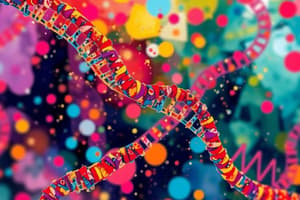Podcast
Questions and Answers
What is the main role of plasmid vectors in biotechnology?
What is the main role of plasmid vectors in biotechnology?
- Modify bacterial colonies
- Destroy genetic material
- Enhance host cell replication
- Transfer genes between organisms (correct)
What is the typical size range of plasmids used in lab applications?
What is the typical size range of plasmids used in lab applications?
- 100–200 kbp
- 1–10 kbp (correct)
- 300–400 kbp
- 500–600 kbp
Which component of a plasmid vector is responsible for copying itself during cell division?
Which component of a plasmid vector is responsible for copying itself during cell division?
- Antibiotics
- Selectable markers
- Origin of replication (ori) (correct)
- Restriction sites
What is the purpose of selectable markers in plasmid cloning vectors?
What is the purpose of selectable markers in plasmid cloning vectors?
Why are unique restriction sites needed when inserting genes into a plasmid vector?
Why are unique restriction sites needed when inserting genes into a plasmid vector?
Which statement is true about plasmids?
Which statement is true about plasmids?
What enzymes are typically used to cut a plasmid at specific locations for cloning purposes?
What enzymes are typically used to cut a plasmid at specific locations for cloning purposes?
Which of the following is crucial for successful cloning when selecting appropriate promoter sequences?
Which of the following is crucial for successful cloning when selecting appropriate promoter sequences?
What is the purpose of transforming host cells with recombinant plasmids in cloning experiments?
What is the purpose of transforming host cells with recombinant plasmids in cloning experiments?
Which of the following is NOT a common method for transforming bacteria with recombinant plasmids?
Which of the following is NOT a common method for transforming bacteria with recombinant plasmids?
Why is it important to choose a suitable promoter sequence for cloning experiments?
Why is it important to choose a suitable promoter sequence for cloning experiments?
What role do plasmid vectors play in molecular genetics and biotechnology?
What role do plasmid vectors play in molecular genetics and biotechnology?
Flashcards are hidden until you start studying
Study Notes
Cloning Vectors: Exploring Plasmids as Carriers of Genetic Information
In biotechnology, cloning vectors serve as intermediaries for transferring genes between organisms. A central role is played by plasmid vectors, which have become indispensable tools due to their ease of manipulation and natural ability to replicate separately from host cells' genetic material.
To understand how plasmid cloning vectors function, let’s break down some key concepts:
Structure of Plasmids
Plasmids are circular DNA molecules naturally found within bacteria. Their size typically ranges from 1 kbp (kilobase pair) up to 300 kbp, with most common lab-use applications involving plasmids around 4–7 kbp in length. At one end, they possess an origin of replication (ori) responsible for copying themselves during cell division. To facilitate incorporation into target organisms and ease extraction afterwards, plasmids often contain antibiotic resistance markers known as selectable markers—such as those conferring ampicillin or kanamycin resistance—thus enabling selection of transformed bacterial colonies.
Designing Restriction Sites for Insertion
When using a plasmid vector, you will need to insert your gene(s) of interest into it. This process involves creating unique restriction sites on either side of the inserted sequence. For instance, if we want our new construct to carry a specific gene inside a pUC-based plasmid (a popular choice), we would cut the plasmid at two specific locations using enzymes like EcoRI or XbaI; these cuts create complementary sticky ends suitable for ligating together the desired fragment along with the backbone DNA.
Choosing Appropriate Promoter Sequences
Another vital aspect of successful cloning requires selecting appropriate promoter sequences that initiate transcription of the gene(s) of interest. Depending on the target organism, different promoters can drive higher expression levels compared to others, making them more desirable candidates. Commonly used promoters stem from various sources such as viruses, phage lambda, or other well-characterized prokaryotic genes.
Transforming Host Cells with Recombinant Plasmids
Once designed and assembled, the recombinant plasmid needs to enter its final host cell where it can transcribe and translate its contents. Bacteria, yeast, insect, plant, or mammalian cells can all act as hosts depending upon the intended application. In general, chemical methods like calcium chloride-mediated transformation are sufficient when working with bacteria. However, alternative techniques such as electroporation, heat shock, sonication, or physical agar plate contact may prove useful under certain circumstances.
Cloning vectors – particularly plasmid ones – form a fundamental building block of modern molecular genetics and biotechnological advancements. With continued refinement, improvement, and creative thinking, researchers push boundaries in exploring novel ways for designing better plasmid vectors tailored to meet the evolving demands of global science efforts.
Studying That Suits You
Use AI to generate personalized quizzes and flashcards to suit your learning preferences.




